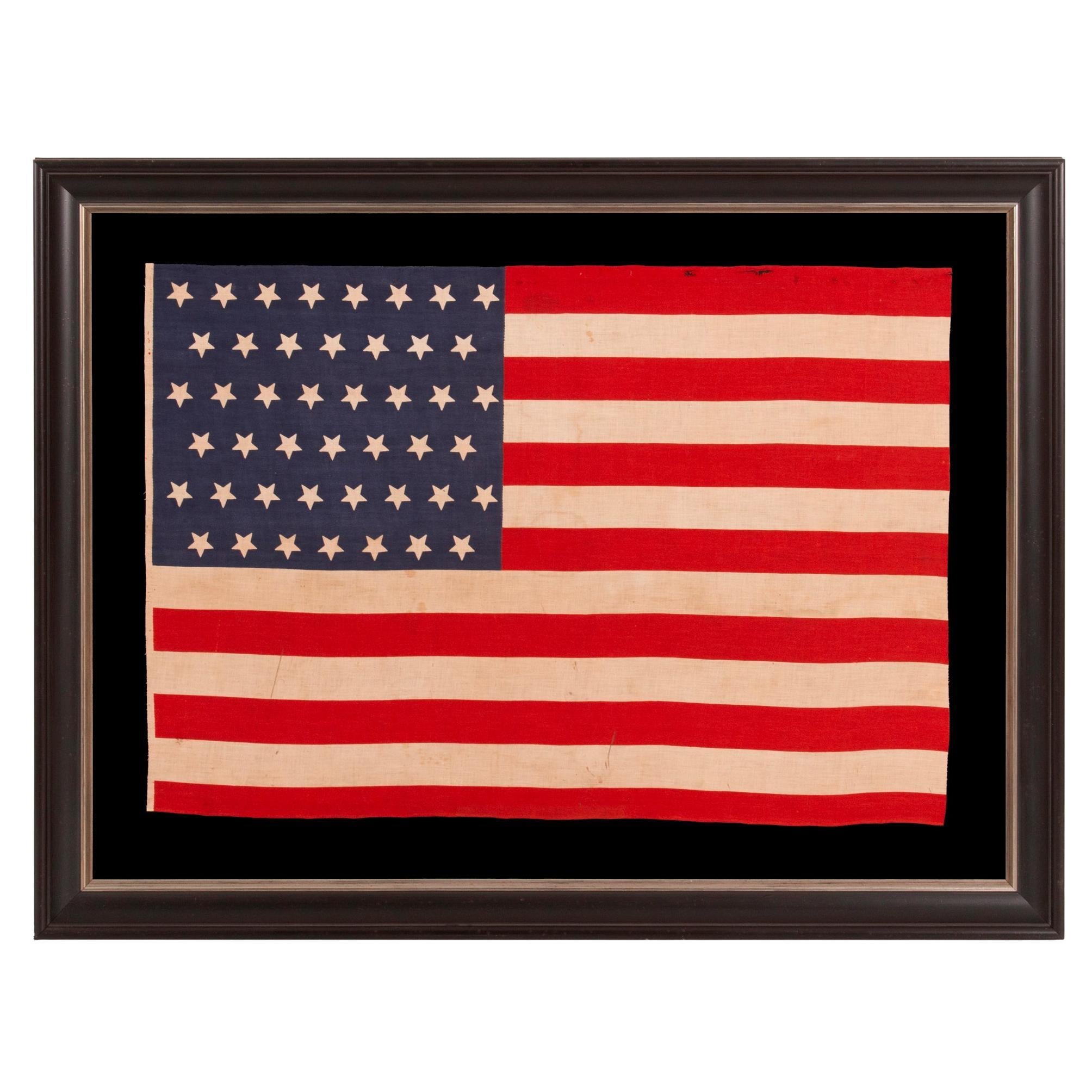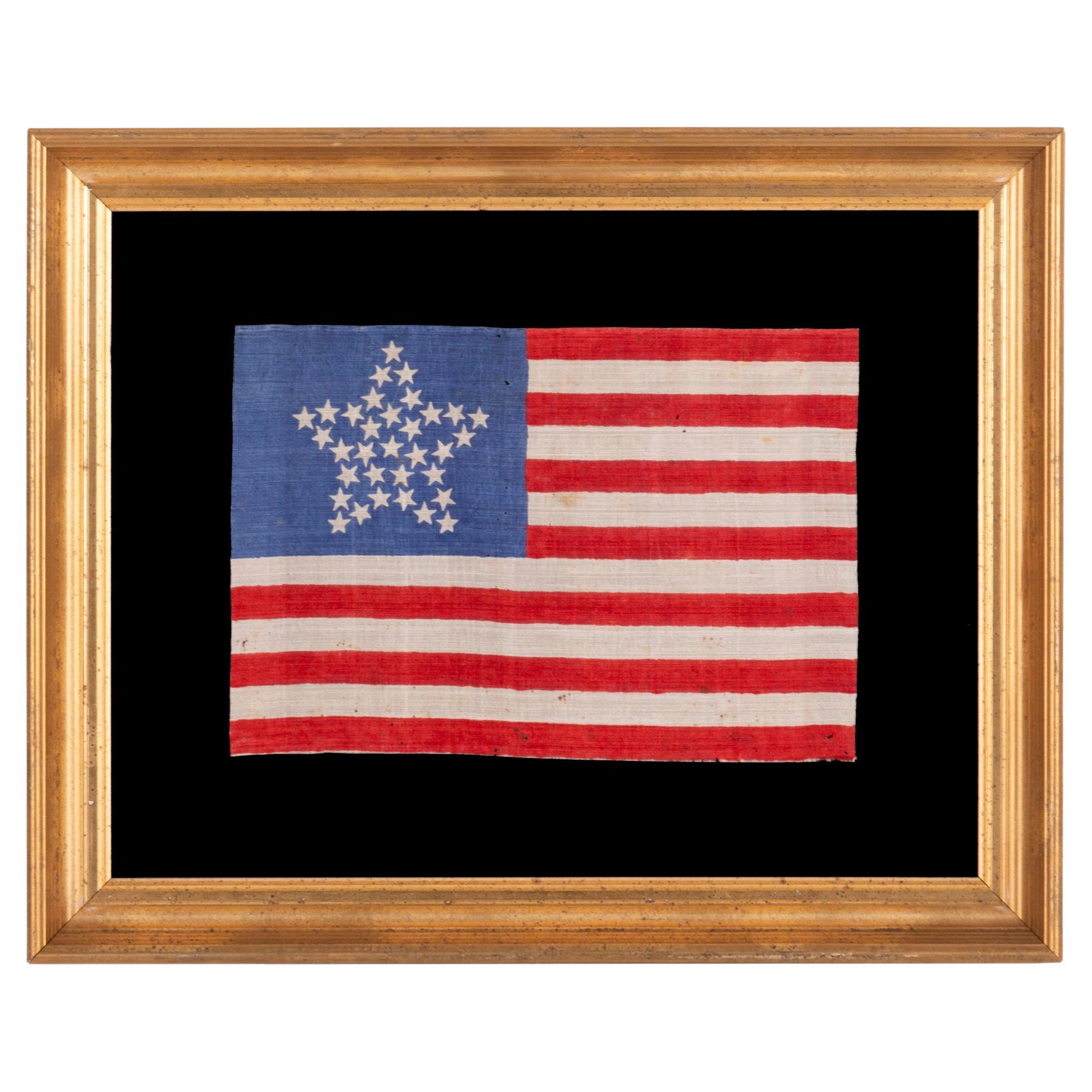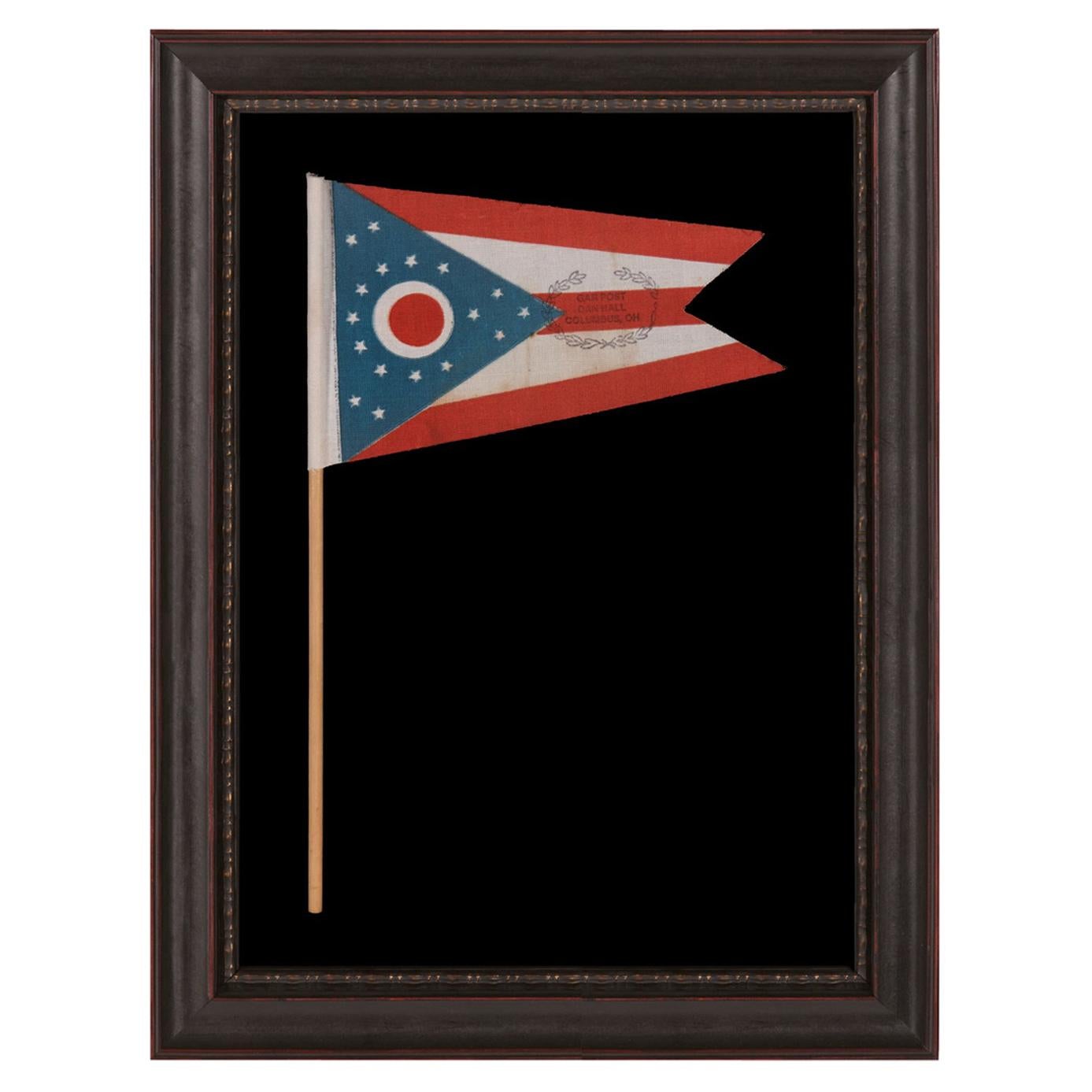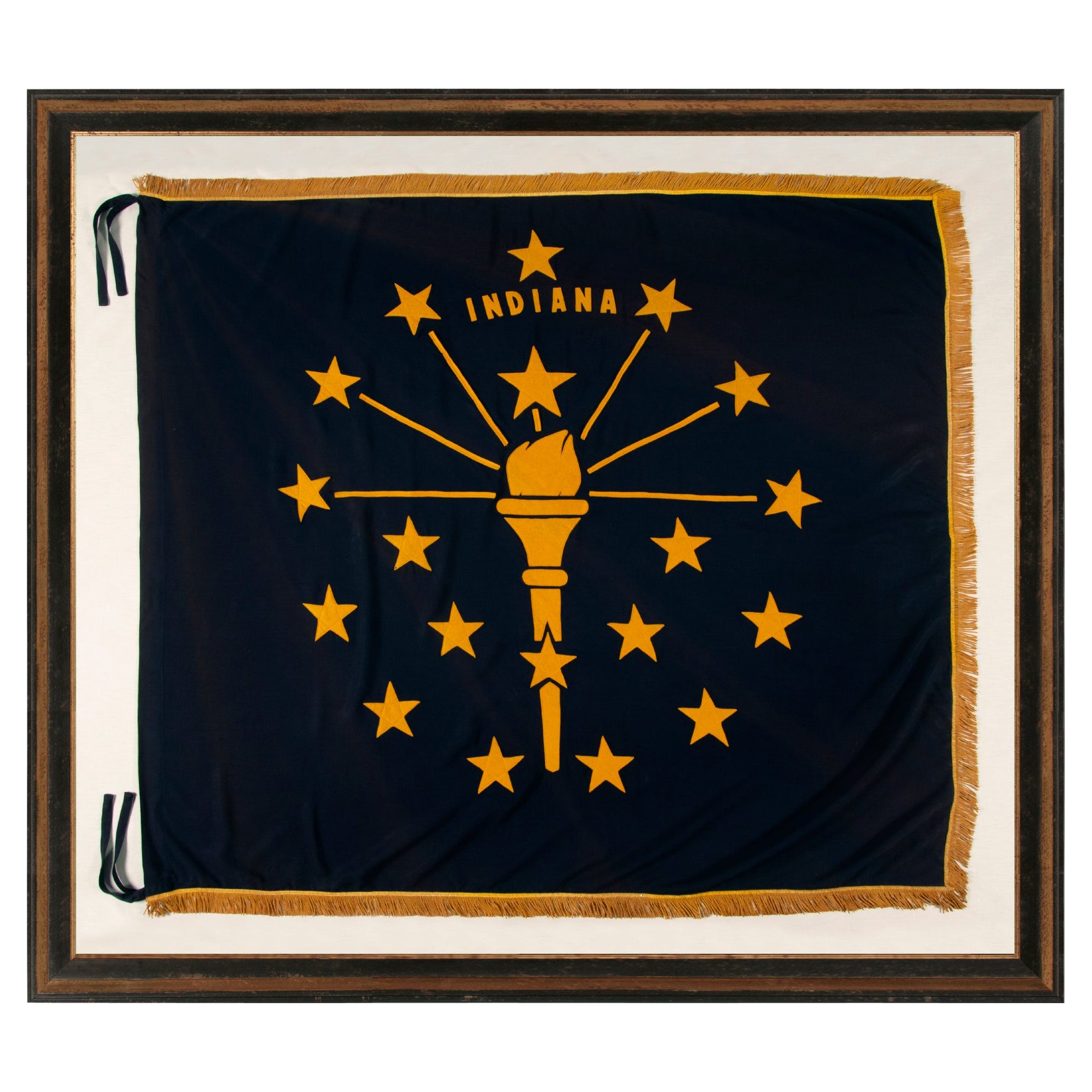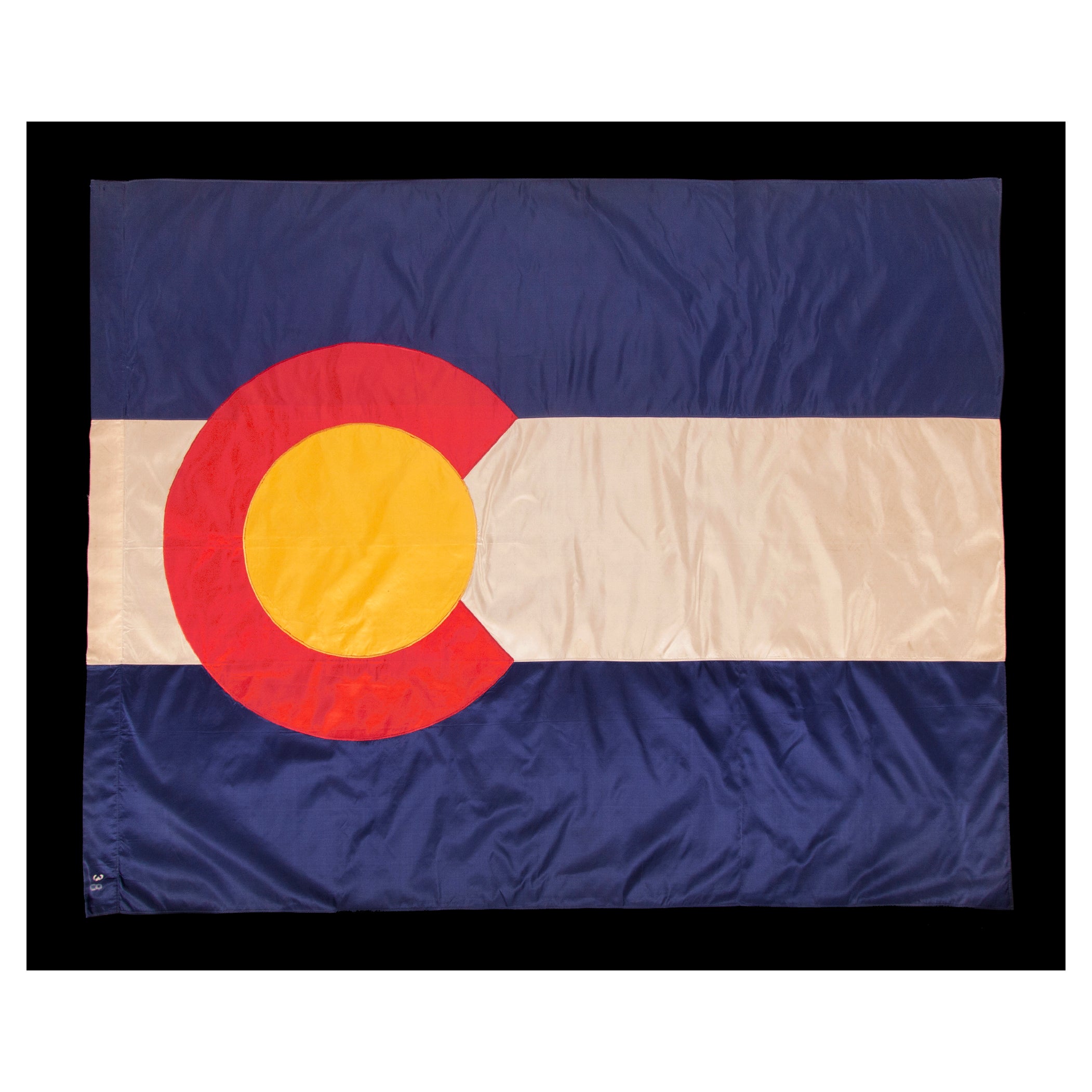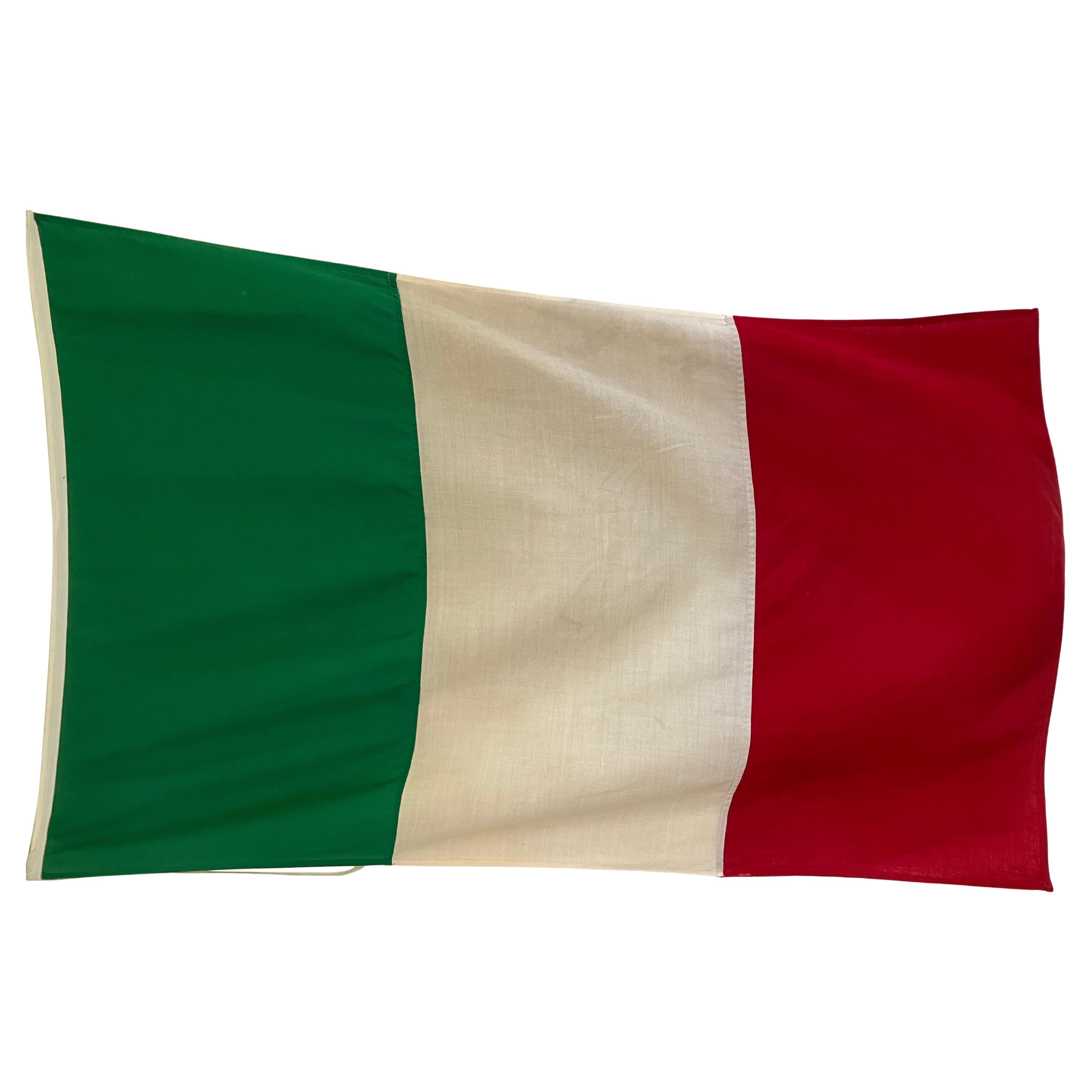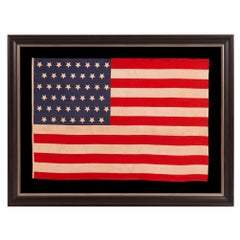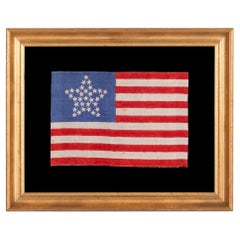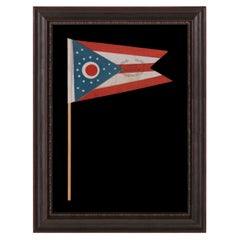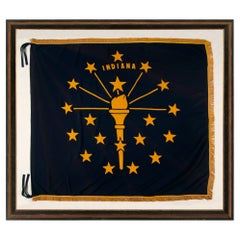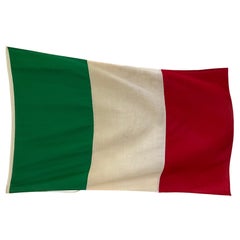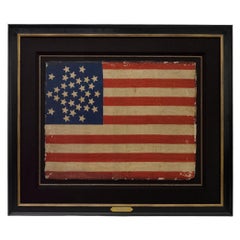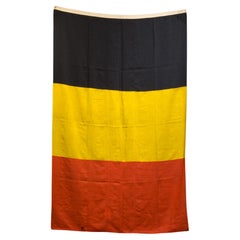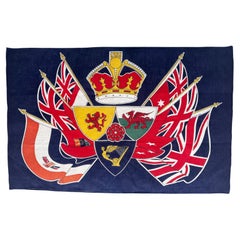Items Similar to Vintage California State "Bear" Flag, ca 1940-1960
Want more images or videos?
Request additional images or videos from the seller
1 of 7
Vintage California State "Bear" Flag, ca 1940-1960
$6,750
£5,153.59
€5,954.93
CA$9,475.72
A$10,561.68
CHF 5,541.35
MX$128,975.33
NOK 70,165.55
SEK 66,317.12
DKK 44,444.26
About the Item
VINTAGE CALIFORNIA STATE "BEAR" FLAG OF STOUT CONSTRUCTION, AND WITH SIGNIFICANT GOLDEN BROWN OXIDATION THAT LENDS TO BEAUTIFUL PATINA AND CONVEYS ITS AGE; LATTER 1940’s - 1960’s
Early state flags fall between very scarce and extraordinarily rare in the antiques marketplace. One primary reason for this is that most states, even if they existed during the 18th or 19th century, didn’t actually adopt flags until the early 20th century. The Maryland State Legislature, for example, didn’t find need for a state banner until 1904, in spite of the fact that Maryland was one of the original 13 colonies. Other states had crests or symbols that were tied to the state legislature in some way, or to local patriotism, but didn't accept an official design until many years following statehood.
In the case of California, the "Bear Flag," as all California state flags and variations thereof are often called, is based on a significant early example. The eldest surviving Bear Flag is thought to date to the 1846 “Bear Flag Revolt”. This occurred when Major John Frémont arrived in the state on a so-called mission to reach the Pacific and encouraged an uprising against Mexican rule in the territory. Frémont claimed himself military governor of the California Republic and was brought up on charges of treason for his actions, but was pardoned by President James Polk. Polk was an expansionist and Frémont’s actions brought California to statehood in 1850, immediately following the 1849 Gold Rush.
The original Bear Flag was designed and made by William L. Todd, a first cousin to Abraham Lincoln’s wife, Mary Todd. Painted on cotton, it had a white field with a red stripe along the bottom, just like the modern design. The star image was taken from what was known as the “California Lone Star Flag”, flown during California's previous, 1836 revolt. Like the modern California flag, the red star appeared the upper hoist-end corner, but the bear was placed next to the star. On a later version, designed by a man named Peter Storm in 1870, the bear was fierce and walking. On the modern design it is black and brown, centered on the field, prominently huge, and walking.
The bear on the first bear flag and other early bear flags more closely resembles the more common American black bear than a grizzly, seen in the lack of shoulder hump and narrower muzzle. The bear on Storm’s 1870 version closely resembles the coat of arms of Bern, Switzerland, its capital city. The coat of arms displays a black bear walking toward the left with fierce claws and a protruding tongue. It is of interest to note that Switzerland was the home country of John Sutter, who established Sutter's Fort, in the area which would spawn the California Gold Rush and eventually become Sacramento, California's state capital.
On Todd’s 1846 flag, the words “California Republic” likewise appeared in black, but the letters spanned the width of the star and bear images and placed immediately below them. Today they are positioned between the red bar and the bear device. Unfortunately Todd’s flag was destroyed in the fires following the 1906 San Francisco earthquake, but an image of it was captured in an 1890 photograph.
It is of interest to note that the bear flag did not become the official California state flag until it was adopted by the California State Legislature and signed into law by Governor Hiram Johnson in 1911. States were regularly participating in World’s Fair events by this time—popular between the late 19th and mid 20th centuries—and were probably compelled to create state banners because other states were doing so. Fair committees were no doubt requesting that states submit the official designs for their seal and flag, and anyone not doing so would be left out of displays where all were shown, etc.
Because state flags are desired by modern antiques enthusiasts and because early copies are scarce or non-existent, I am sometimes compelled to acquire interesting vintage examples from the mid-20th century. This particular "bear flag" was likely made between approximately 1940 and the 1960’s. Though unsigned, like most flags of the early-mid 20th century and prior, is of notably stout construction, with an unusually wide binding along the hoist and two uncommonly substantial copper grommets, stamped with a numeral “2.” The bear device, star, and lettering were printed on either heavy cotton bunting or a blended cotton fabric, in a variant of the mothproof types being adopted by flag-makers to replace wool bunting. This is an especially attractive example, obviously flown for a lengthy period, beautifully oxidized throughout to a weathered, golden tan, soiled and wind whipped from obvious use. The fly end was hemmed by way of 4 vertical rows of stitching, the maximum one will see in a flag of this size and likewise unordinary. The bear device remains strong, while the red bar and star are pleasantly faded. All of the piecework and hemming was accomplished by machine stitching.
Mounting: For 25 years we have maintained a specialized department for this purpose. Our lead conservator holds a master's degree in textile conservation from one of the nation’s top university programs. We take great care in the mounting and preservation of flags and related textiles and have preserved thousands of examples.
The background is 100% cotton twill, black in color, that has been washed and treated for colorfastness. The black-painted and hand-gilded molding, with its wide, serpentine profile, is Italian. The glazing is U.V. protective acrylic (Plexiglas). Feel free to contact us for more details.
Condition: In addition to the soiling and fading discussed in the above narrative, there is an area of significant loss from wind shear in the upper, fly end corner. Fabric of similar coloration was placed behind this for masking purposes. Many of my clients prefer early flags to show their age and history of use. The flag presents beautifully.
Frame Size (H x L): Approx. 46.5" x 65"
Flag Size (H x L): 34.5" x 52.75"
- Dimensions:Height: 46.5 in (118.11 cm)Width: 65 in (165.1 cm)Depth: 2.5 in (6.35 cm)
- Materials and Techniques:
- Place of Origin:
- Period:
- Date of Manufacture:1940-1960
- Condition:Wear consistent with age and use. See Item Description.
- Seller Location:York County, PA
- Reference Number:Seller: ofj-10031stDibs: LU849746018922
About the Seller
5.0
Recognized Seller
These prestigious sellers are industry leaders and represent the highest echelon for item quality and design.
Established in 1991
1stDibs seller since 2008
70 sales on 1stDibs
Typical response time: 1 to 2 days
- ShippingRetrieving quote...Shipping from: York County, PA
- Return Policy
Authenticity Guarantee
In the unlikely event there’s an issue with an item’s authenticity, contact us within 1 year for a full refund. DetailsMoney-Back Guarantee
If your item is not as described, is damaged in transit, or does not arrive, contact us within 7 days for a full refund. Details24-Hour Cancellation
You have a 24-hour grace period in which to reconsider your purchase, with no questions asked.Vetted Professional Sellers
Our world-class sellers must adhere to strict standards for service and quality, maintaining the integrity of our listings.Price-Match Guarantee
If you find that a seller listed the same item for a lower price elsewhere, we’ll match it.Trusted Global Delivery
Our best-in-class carrier network provides specialized shipping options worldwide, including custom delivery.More From This Seller
View All45 Upside-Down Star on An Antique American Flag, Utah State, ca 1896-1908
Located in York County, PA
45 UPSIDE-DOWN STARS ON AN ANTIQUE AMERICAN FLAG MADE IN THE ERA OF THE SPANISH-AMERICAN WAR (1898), WHEN UTAH WAS THE MOST RECENT STATE TO JOIN THE UNION, circa 1896-1908
45 star A...
Category
Antique Late 19th Century American Political and Patriotic Memorabilia
Materials
Cotton
33 Star Flag with Stars in a "Great Star" Pattern, Oregon State, ca 1859-1861
Located in York County, PA
33 STARS IN A "GREAT STAR" PATTER ON A BRILLIANT, ROYAL BLUE CANTON, A RARE AND EXTRAORDINARY EXAMPLE, PRE-CIVIL WAR THROUGH THE WAR'S OPENING YEAR, 1859-1861, OREGON STATEHOOD
33 s...
Category
Antique Mid-19th Century American Political and Patriotic Memorabilia
Materials
Silk
Ohio State Parade Flag with a Civil War Veterans Overprint
Located in York County, PA
OHIO STATE FLAG WITH CIVIL WAR VETERANS' OVERPRINT FROM THE GRAND ARMY OF THE REPUBLIC POST IN COLUMBUS, MADE IN MOURNING OF THE 1925 PASSING OF NATIONAL G.A.R. COMMANDER IN CHIEF DANIEL M. HALL, WHO ALSO SERVED AS COMMANDER OF THE OHIO DEPARTMENT OF THE G.A.R., AS WELL AS THE LOCAL CHAPTER
Flag of the State of Ohio, printed on oilcloth-like cotton, affixed to its original wooden staff. Made for Civil War veteran's use, the flag bears a stamped overprint in the striped field that consists of an open wreath of laurel branches, inside which is the following text: “GAR [Grand Army of the Republic] Post, Dan Hall, Columbus, OH”.
Born on October 20th, 1842, Daniel M. Hall enlisted with the Union Army as a Private at the age of 18 on August 25th, 1861. On October 8th of that year he mustered into the Co. H of the 2nd Ohio Cavalry. Discharged for disability on June 28th, 1862, he reenlisted approximately 17 months later, on November 11th, 1863, and mustered into Co. F of the 12th Ohio Cavalry at Camp Cleveland. He was at some point promoted to the rank of Sergeant, and, on February 21st, 1864, to the rank of Corporal. He mustered out at Nashville on November 14th, 1865.
Hall mustered into the Hamlin Post of the Ohio G.A.R. on May 23rd, 1883. He would go on to serve not only as Commander of the Dept. of Ohio for the organization, but as National Commander of the entire Grand Army of the Republic.
The Grand Army of the Republic was the primary veterans association for Union Civil War soldiers. Founded in 1866, its members dressed up in Civil War uniforms, attended parades and reunions, and the organization was somewhat more fraternal in nature than today’s VFW or American Foreign Legion.
Flags overprinted for the purpose of advertising are a specialized form in American flag collecting. A flag with a basic G.A.R. overprint is the most common type. This might be accompanied by a post number and a date. More elaborate the overprints are more highly desired, such as this one, which is the only variation I know of that honors a particular person who was not the namesake of the chapter itself.
It is of interest to note that a sister variety of 48 star parade flag is known, printed on the same fabric, that bears the same overprint, accompanied by the words: “We Mourn Our Comrade." From the additional text on the 48 star variety, one can extrapolate that the flags were made to mourn the passing of this important leader of Civil War veterans on October 19th, 1925, just one day before his 83rd birthday.
The State Flag of Ohio was designed in 1901 by Cleveland architect John Eisenmann, who designed the Ohio building for the state's exhibition at the Pan American Exposition World's Fair in Buffalo, New York. It was officially adopted by the Ohio legislature on May 19th, 1902. It's elements are centered on a red disc, set against a circular white ground that forms a letter "O." This simultaneously represents a buckeye, the fruit of the state tree and an iconic Ohio symbol. The flag's 5 stripes are said to represent the state's waterways and roads, while the triangular shape of the union is said to illustrate hills and valleys. The presentation of 13 stars along the hoist end, arranged in a semi-circular medallion with two off-set stars above and below, reflects the original 13 colonies. The diamond of stars, towards the fly end. bring the overall count to 17 to reflect Ohio's admission. When the design was adopted by the state legislature, the position of these stars was changed slightly, moving them further around the circle to form a wreath.
Flag expert Whitney Smith, who coined the term Vexillology in the late 1950's (the accepted term for the study of flags), pointed out that the format of the flag itself was reminiscent of Civil War cavalry guidons, carried by Ohio regiments throughout the state. These were of swallowtail form, though with 13 stripes, all horizontal and 90 degrees to the hoist. Most often these had circular star patterns around an open center, which makes them even more similar to the Ohio flag...
Category
Vintage 1920s American Political and Patriotic Memorabilia
Materials
Cotton
Indiana State Flag, with Gold Fringe circa 1930-1955
Located in York County, PA
Indiana State Flag With Square-like Proportions, An Offset Device, And Gold Fringe, Circa 1930-1955:
Despite the fact that most of the United States joined the Union during the 18...
Category
20th Century American Political and Patriotic Memorabilia
Materials
Cotton
Price Upon Request
Colorado State Flag, Made of Silk, circa 1911-1920
Located in York County, PA
COLORADO STATE FLAG OF EXCEPTIONAL QUALITY, MADE OF SILK, CIRCA 1911-1920’s, EXTRAORDINARILY RARE IN THIS PERIOD AND THE EARLIEST EXAMPLE THAT I HAVE EVER ENCOUNTERED
Early state flags are few and far between. While I am asked for them constantly, most states did not actually have official flags until the 20th century.
On May 6th, 1911, Colorado became among the last to adopt a design. The project of doing so was spearheaded by the Denver Chapter of the Daughters of the American Revolution. The bill was introduced by Senator W.H. Sharply and adopted by the Eighteenth General Assembly. The artwork was the product of A.C. [Andrew Carlisle] Carson, President of the Ohio Society of Colorado. The meanings behind the elements in the design are as follows: The large letter "C" stands for Colorado and simultaneously for the Centennial State (Colorado entered the Union in 1876, the year in which our nation celebrated its 100th anniversary of independence), as well as the Columbine State (reflecting the state flower). The red color is included due to the fact that the word Colorado translates to scarlet or red in Spanish. The circle represents the sun, while the gold color symbolizes all-the-year sunshine, Colorado’s status as the greatest gold state, and one Columbine color. It was also included so that the Colorado state flag would have one more color than the U.S. flag. The color white reflects Colorado’s status as the greatest silver state, its eternal mountain snow, and one Columbine color. Lastly, the shade of Yale blue symbolizes all-the-year blue sky and one Columbine Color. Members of the D.A.R. were proud to note that this was also their color.
Made sometime between the initial year of the adoption of this design and the 1920’s, this particular flag is the earliest Colorado example that I have ever encountered. The blue and white bars, red “C,” and golden circle are a’’ made of silk taffeta. This was a costly fabric, reserved for the best material a flag-maker produced. The flag is constructed in the manner of a battle flag, to be carried on foot. Squarish in its overall profile, silk was the fabric of choice for flags employed in this function, due to the fact that it was light weight, and thus practical for hand-carrying, while simultaneously formal in appearance, appropriate for the sort of ceremonial use that military presentation often demands. The style of the hoist is also typical for field or parade use. Here the fabric was rolled over to form an open sleeve, through which a wooden staff could be inserted. The sleeve is lined on the interior with black cotton. Leather tabs, at the top and bottom, fit over metal posts on the staff, designed to accept them, to fix the flag in its proper position.
The bars were pieced and joined with lineal machine stitching. The hoist and fly ends were finished and hemmed by the same method. The devices are double-appliquéd (applied to both sides) with a machine buttonhole / blanket stitch. Though machines that produced buttonholes were, remarkably, available alongside the earliest standard machines, in the 1850’s and 60’s, the use of this sort of stitch in a running format, for appliqué work, remained highly unusual, even as late as the first half of the twentieth century, probably because it used a ton of thread when compared to the zigzag or satin stitch. It could be expected to appear more often in the hands of a maker of very fine flags, that employed embroidery machines and commissioned custom, fancy work of all sorts. Though unsigned—in no way uncommon in early examples, which were seldom signed—that is precisely the sort of firm that produced the Colorado flag...
Category
Early 20th Century American Political and Patriotic Memorabilia
Materials
Silk
Price Upon Request
"Lion Rampant" Royal Flag of Scotland, ca 1875-1900
Located in York County, PA
THE ROYAL FLAG OF SCOTLAND, a.k.a., “LION RAMPANT,” A GLAZED COTTON PARADE FLAG, LAST QUARTER 19th CENTURY
Parade flag in the form of the Royal Flag of Sco...
Category
Antique Late 19th Century Scottish Political and Patriotic Memorabilia
Materials
Cotton
Price Upon Request
You May Also Like
Vintage Italian Flag
Located in New York, NY
Vintage Italian flag. Vintage Italian flag made by Serpone & Co. Napoli. Italy, Mid-20th Century.
Approximate dimensions: 38” H X 60” W
Category
Mid-20th Century Italian Mid-Century Modern Political and Patriotic Memo...
Materials
Fabric, Cotton, Linen
31-Star Printed American Flag, Celebrating California Statehood, Circa 1850
Located in Colorado Springs, CO
This is a rare 31-star medallion printed American flag, celebrating the addition of California to the Union. The flag is printed on silk and has a spectacular “Great Star” canton pat...
Category
Antique 1850s American Political and Patriotic Memorabilia
Materials
Silk
Early 20th c. Monumental Belgian Flag c.1940-1950
Located in San Francisco, CA
ABOUT
An original monumental Belgian flag.
CREATOR Unknown.
DATE OF MANUFACTURE c.1940-1950.
MATERIALS AND TECHNIQUES Wool, Metal.
CONDI...
Category
Early 20th Century Industrial Political and Patriotic Memorabilia
Materials
Brass
$270 Sale Price
41% Off
Vintage British Empire Dominion Coronation Flag
Located in Hastings, GB
Patriotic British Coronation Dominions Flag
British Royal Family
The flag represents the British Empire and the unity between the UK and its dominions during the coronation of King ...
Category
Mid-20th Century British Political and Patriotic Memorabilia
Materials
Cotton
Monumental "Valley Forge" American Flag with 48 Stars, c.1940-1950
Located in San Francisco, CA
About
This is an original monumental American flag made by Valley Forge Co. with 48 stars and stripes and brass grommets.
Creator Valley Forge Co.
Date of manufacture c.1940-1950.
...
Category
Early 20th Century Industrial Political and Patriotic Memorabilia
Materials
Brass
Large Hand Sewn American Flag with 48 Stars c.1940-1950
Located in San Francisco, CA
ABOUT
A large hand sewn American flag made with 48 hand sewn stars and stripes with brass grommets to hang.
CREATOR Valley Forge Flag Co.
DATE OF MANUFACTURE c.1940-1950....
Category
Early 20th Century Industrial Political and Patriotic Memorabilia
Materials
Brass
More Ways To Browse
Vintage Wool Military Coat
Buermann Spurs
Scary Antique Toys
Alice Tack
Civil War Cannon Balls
Leo Cherne
Vintage 49 Star Flag
Antique Scary Dolls
Vintage Asafo Flags
Eagle Of The French National Guard
Vintage Defiance Flag
Tar Bucket
Ron Nixon
Patriotic Handkerchief
Ethan Allen Framed Art Print
Vintage Texas Flag
Mason And Hamlin
Antique Truncheon
